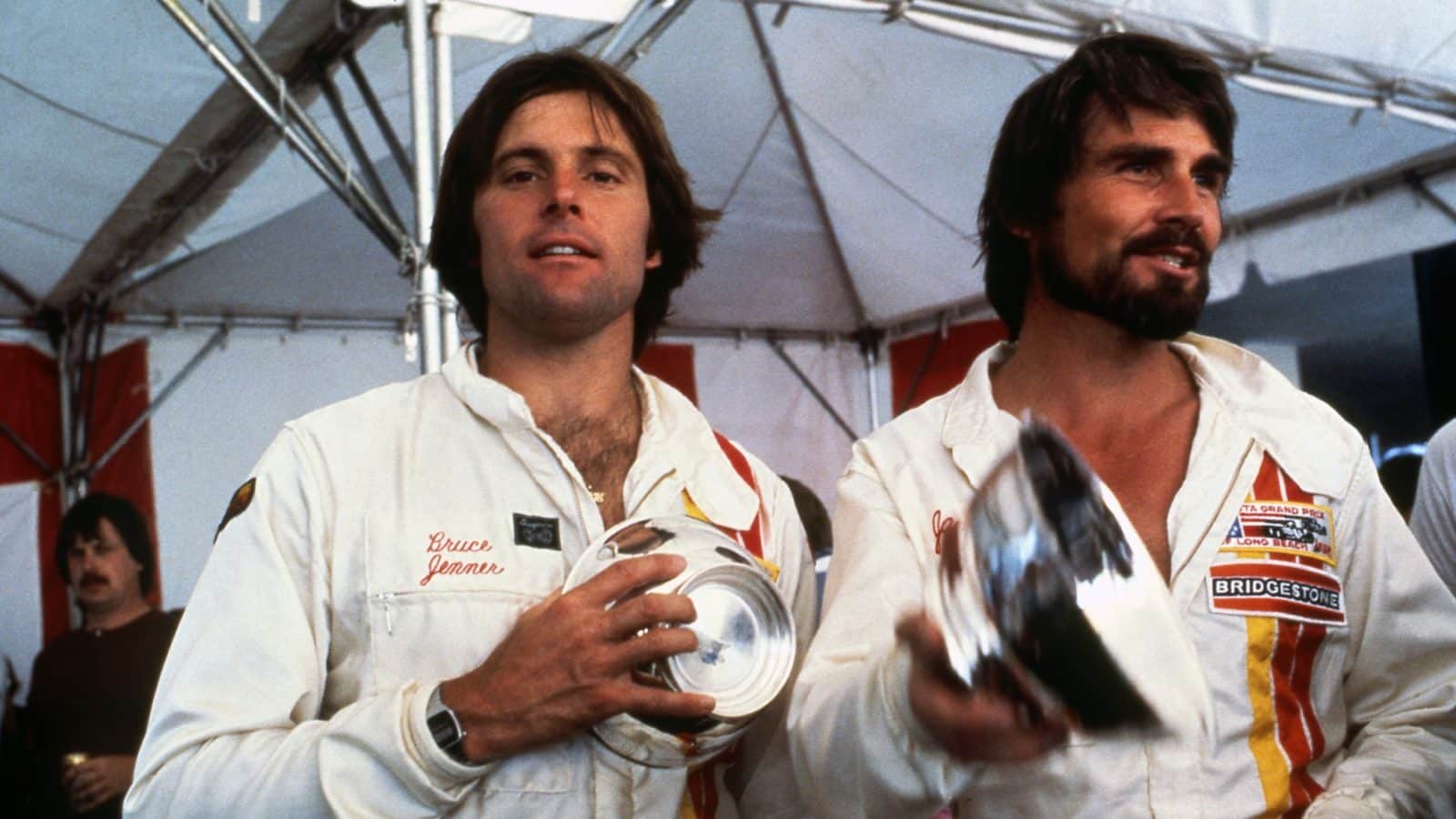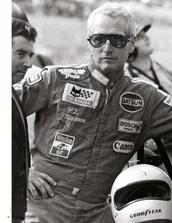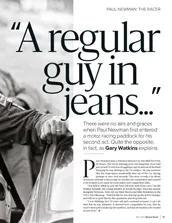The Jenner racing story starts before his rise to celebrity with decathlon gold at the 1976 Montreal Olympics. It really goes all the way back to the teenage years of a self-confessed petrolhead who fell in love with his father’s Austin-Healey Sprite as a teenager – and was then devastated to find that it had been sold on the very day that he passed his driving test. The first connection with motor racing came in 1975, however.
A friend who was head of PR at Laguna Seca invited the new decathlon world record holder – a resident of San Jose just down the road from the Californian track – to be grand marshal at the circuit’s IMSA fixture. The athlete was immediately hooked on a new sport.
“I thought it was way too cool,” recalls Jenner. “I remember saying to myself that if I ever got the chance to race, I was going to do it.”
That chance came less than three years after the Montréal success in the athletics stadium. Jenner was invited to compete in the Toyota Pro-Celebrity one-make saloon race on the bill of the 1979 US Grand Prix West at Long Beach.
A chaotic first lap allowed Jenner to move into a massive lead thanks to the carnage behind. That’s where he stayed over the remainder of the race, against both the celebrities and the pros.
“I was all on my lonesome out front, so I thought I’ve got this one,” says Jenner. “Then I see another car in my mirrors, and he’s getting a little closer and a little closer. I was thinking, it’s only 10 laps, don’t overdrive and don’t make a mistake.
“He certainly moved up quite a bit, but finally the chequered flag came out and he was probably 10 car lengths behind. I slowed down and looked across, and who pulls up besides me but Al Unser Sr. I thought to myself, thank God I didn’t know I had the Indy 500 winner behind me [Unser had taken the third of his four wins at the Brickyard the previous May]. If I had, I’m sure I would have overdriven the thing.”
The celebrity race ignited the racing fires of a now-former athlete who made no bones about a desire to cash in on his fame after leaving his vaulting poles in the Montréal stadium. Racing was about fun, however.
“I really got the bug after that,” says Jenner. “Some friends and I went out and bought twin-engined karts and used to go testing at the weekends, just for fun.”
<p class=”pull-quote-right”>“I don’t know much about sports where you run, jump and throw a stick, but I do know that Bruce was one helluva race car driver”</p>
Jenner’s first race of significance came with an invitation to drive a BMW M1 at the 1980 Daytona 24 Hours. It wasn’t any old M1, rather a car built by British racing car constructor March for the Group 5 silhouette regs and now running in IMSA’s GTX class with Jim Busby Racing.
The link with Busby came via one of his team-mates, Rick Knoop. The initial contact was followed by a test at the Willow Springs Raceway, an hour or so out of Los Angeles.
“We put him in the car out at Willow, which was a place where you were in trouble if you went off, and ran him into the ground,” recalls Busby. “He never flinched and certainly never went off. I thought, this guy is fast – he was within a few tenths of me.
“I don’t know much about sports where you run, jump and throw a stick, but I do know that Bruce was one helluva race car driver. He did bring a sponsor, but we didn’t need his money; we were a funded BMW team. I put him in the car for those races because he was quick.”
Jenner drove the BMW at both Daytona and the Sebring 12 Hours in 1980, but failed to register a finish either time. The transmission was the car’s weak spot. He made sporadic IMSA outings over the remainder of the season at the wheel of a Porsche 935 run by Andial Racing, the Electrodyne team’s 934 and then a Chevrolet Monza.
There would be no more racing for Jenner, apart from a victorious return to the Long Beach pro-celebrity race in 1982 and another overall victory (this time in front of Dan Gurney), for a couple of seasons. He didn’t disappear from the IMSA scene, however. Helmet was swapped for microphone and Jenner became a pitlane reporter for NBC.
“I told Ford that I would do the full season, but that I wanted Pruett as my co-driver. After they’d seen him in a couple of races, it was a done deal”
The desire to race had never gone away and Jenner’s TV work resulted in him forging a link with Ford that allowed him to make it back into the cockpit. He started out with Brooks Racing, a team running a Ford Thunderbird GTO with factory support, with occasional appearances in 1983 and ’84. From there, he moved upwards to Roush, joining the team that had full-house Ford support early in ’85. His first team-mate was Lyn St James, but he had an eye on a young star of the future. Jenner’s fun days out in his kart on the West Coast had brought him into contact with Scott Pruett.
“I met this young kid who at the time was the God of karting out here,” says Jenner, who had the backing of the 7-Eleven convenience store. “He told me that he wanted to be a professional race car driver and win the Indy 500. I explained that I was just beginning this relationship with Ford, and suggested that maybe he could drive with me. But it took me about a year and a half of talking to Ford to get Scott in the car.”
Pruett remains good friends with Jenner and thankful for the help he was given at the start of a stellar career that did take him to Indy, if not Victory Lane, and also made him a five-time winner of the Daytona 24 Hours.
“Bruce introduced me to the right people and encouraged them to take a close look at me,” says Pruett, who is still racing in the IMSA ranks at the age of 56. Mike Kranefuss [Ford’s racing boss at the time] knew of me because he followed karting, but Bruce was the one who opened the door.”
Pruett and Jenner first shared a Mustang at Road America in August 1985. The young up-and-comer celebrated his mentor’s faith by claiming the class pole. Jenner knew he wanted ‘the kid’ as his full-time team-mate for the following year.
“I told Ford that I would do the full season, but that I wanted Pruett as my co-driver,” says Jenner. “After they’d seen him in a couple of races, it was a done deal.”
Pruett and Jenner dominated the GTO division for tubeframe silhouette racers in ’86. “To be honest, we cleaned up,” is how Jenner puts it.
“Scott’s job was put it on the pole, my job was to go out there and run good, fast laps and not get into trouble. Then I’d hand it back to Scott and let him go.”
They claimed two class wins and a string of podiums when they raced alongside the GTP prototypes, while Pruett won five times in the one-driver, stand-alone GT events. Jenner notched up a couple of podiums on his own, most notably in the three-hour Daytona finale that year.
The highlights of the season came at its beginning. Pruett and Jenner should have made a winning start to their 1986 IMSA campaign when they were joined by three-time Le Mans winner Klaus Ludwig for the Daytona 24 Hours. They led the GTO division for much of the duration, but ultimately ended up second in class and fifth overall after two transmission failures.
They made amends at Sebring, claiming class honours and fourth overall among the faster GTP prototypes. The GTO battle boiled down to a straight fight between the Pruett and Jenner Mustang and an additional Roush entry fielded for Ford NASCAR drivers Bill Elliot and Ricky Rudd. Jenner claimed back then and still insists today that Roush favoured its big-name visitors.
“Jack Roush [the team owner] had given Scotty some specific instructions about what pace he should run,” she recalls. “They had something like 50sec on us, but the team wouldn’t allow him to run any faster. I went to Jack and said, ‘You gotta let my kid go.’ But he was saying that the team had the race sewn up and wasn’t going to risk anything.”
Jenner recalls that his arguments eventually won the day. Roush relented and let his cars race. The final exchanges were both controversial and confused – the exact details have been lost in the mists of time.
What is clear is that the final chapter of the race started when Jenner picked up the pit board and hung it out while the team wasn’t looking and finished when Pruett overtook Rudd on the last corner of the last lap to take victory.
Jenner’s decision to grab the board resulted in Rudd pitting too early to make the finish on another tank of fuel. That meant he was sent through the pitlane and had to come back a handful of laps later.
That handed the class lead to Pruett, who then started to run out of fuel. At the same time, Rudd encountered gearbox problems, pitted and was sent on his way without the use of fifth or sixth gears. Pruett had to stop for a late splash of fuel and then caught the ailing sister car as they went through the fast Turn 17 right-hander for the last time.
“After what had happened at Daytona, I was as happy as could be,” says Jenner. “We’d had something like a 22-lap lead in the 24 Hours and then had victory snatched away from us, so it meant a lot to get that one at Sebring.”
Pruett describes his former team-mate as a “highly motivated racer”. Jenner isn’t so sure: “I was totally obsessed with winning when I was an athlete and that’s why I trained eight hours a day. Racing was different for me; it was something I did because I enjoyed it. I liked winning, but I didn’t beat myself up if I finished second. For Scotty, it was different: racing was his Olympics.”
Jenner more or less stopped racing at the end of 1986, though he did fulfil his ambition of racing a GTP car when he got in a V8-powered Ford Mustang Probe run by the Tom Milner Racing team for Daytona.
“I just had other things to do,” says Jenner. “I was also struggling with my identity at the time, trying to figure out who I was.
“To be honest I thought I would transition before I was 40, but ended up meeting and marrying Kris [Kardashian]. I picked up four more kids and ended up having two more, so now I am up to 10 children.”
Jenner has had more time to renew the passion for motor sport over the past few years since splitting from Kris.
“I still enjoy racing, so I thought why not?” explains Jenner. “My son, Burt, races SuperTrucks [an off-road series that takes place in stadiums], so I’ve tried to help him with sponsors and things and then we raced the Lamborghinis against each other a while back.”
That’s a reference to Jenner’s comeback race in the North American version of the Lamborghini Super Trofeo one-make series. Bruce and Burt competed at the Virginia International Raceway in 2013, the same year that they contested the Baja 1000 off-road event in California together.
Jenner has now raced for the first time since coming out as a transwoman. Early in 2016, Caitlyn took part in a couple of races in what is known as the EXR Spec Series at the Circuit of the Americas in Austin. “I drove well, didn’t put a dent on the car and ended up with two thirds,” says Jenner. “Why should I give up the things I enjoy because I have transitioned?”
Jenner insists that she remains a petrolhead – despite what she calls “the changes in my life” – and that explains why these days she can be seen buzzing around in a newly restored bugeye Sprite.



